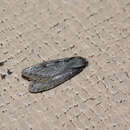en
names in breadcrumbs


Semioscopis avellanella is a species of moth of the family Depressariidae. It is found in most of Europe (except most of the Balkan Peninsula and the Iberian Peninsula ) east to the eastern parts of the Palearctic realm.
The wingspan is 20–26 mm. The forewings are rosy-grey whitish, sprinkled with pale fuscous; a dark fuscous streak from base along fold to 1/3, thence bent upwards to disc before middle; second discal stigma forming a dark fuscous angulated mark; some dark fuscous scales tending to form dots on costa and termen; 2 and 3 separate. Hindwings are pale greyish. The larva is whitish-green; dorsal line darker; head and plate of 2 green.[2]
Adults are on wing from March to April.[3]
The larvae feed on Betula, Tilia (including Tilia cordata) and Carpinus species.[4] They feed inside a folded or rolled leaf of their host plant. Pupation takes place in detritus. The species overwinters in the pupal stage.[5]
Semioscopis avellanella is a species of moth of the family Depressariidae. It is found in most of Europe (except most of the Balkan Peninsula and the Iberian Peninsula ) east to the eastern parts of the Palearctic realm.
The wingspan is 20–26 mm. The forewings are rosy-grey whitish, sprinkled with pale fuscous; a dark fuscous streak from base along fold to 1/3, thence bent upwards to disc before middle; second discal stigma forming a dark fuscous angulated mark; some dark fuscous scales tending to form dots on costa and termen; 2 and 3 separate. Hindwings are pale greyish. The larva is whitish-green; dorsal line darker; head and plate of 2 green.
Adults are on wing from March to April.
The larvae feed on Betula, Tilia (including Tilia cordata) and Carpinus species. They feed inside a folded or rolled leaf of their host plant. Pupation takes place in detritus. The species overwinters in the pupal stage.